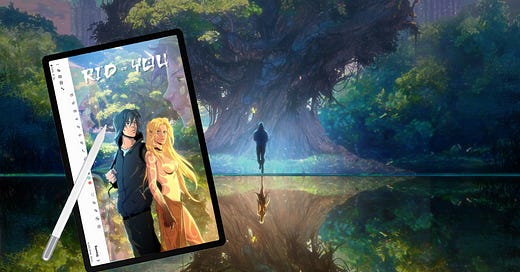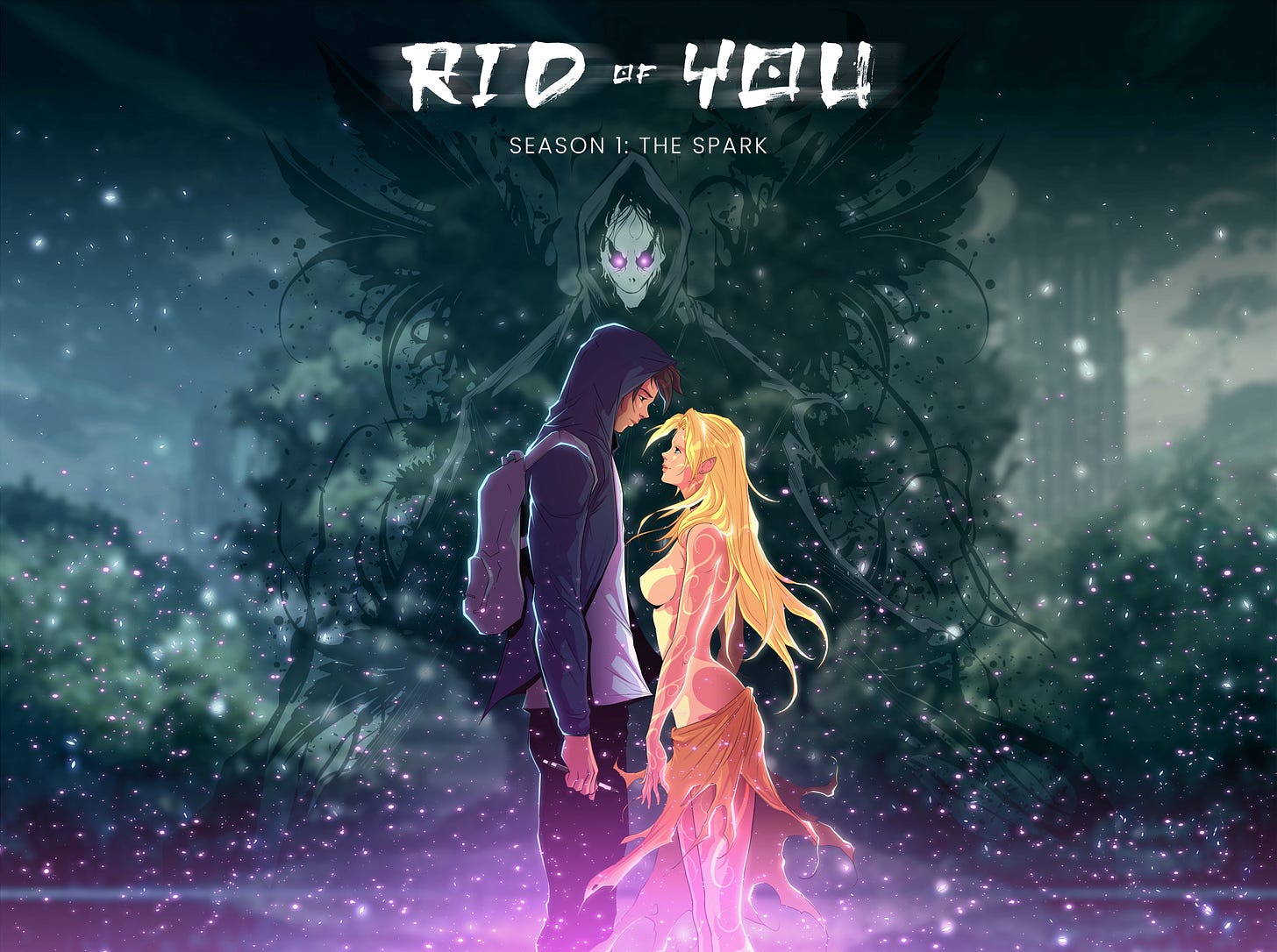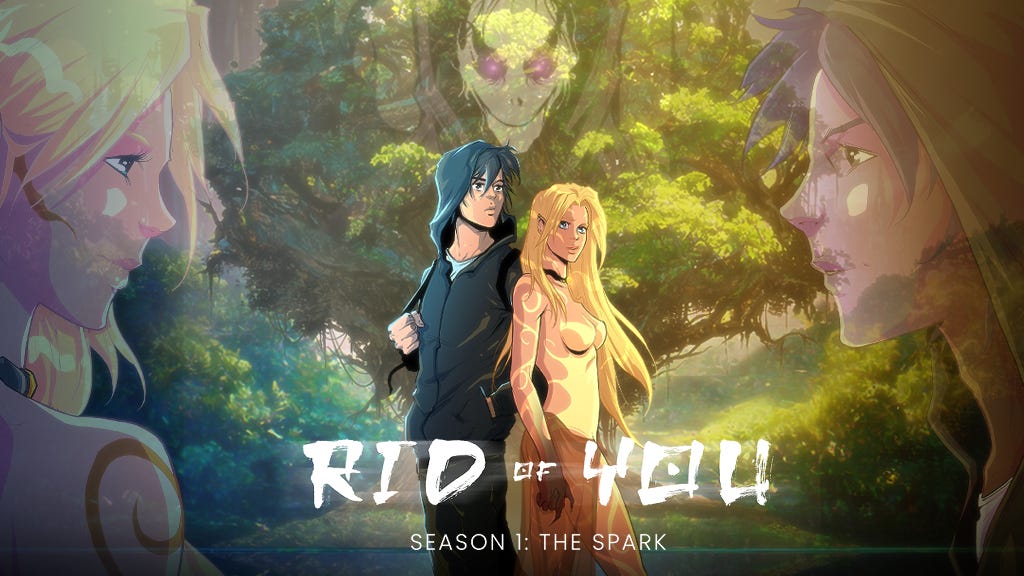🎨 The Art Direction of a Graphic Novel
The secrets behind the art direction that transforms mere illustrations into immersive narratives
The Art Direction of Rid of You
And my day-to-day role as an Art Director within publishing, advertising and entertainment has me constantly defining, categorising and ‘selling’ art styles to clients.
A great example of this is for my latest art direction for a Ubisoft / Division 2 trailer.
And my approach in producing graphic novels is no different.
A part of my creative process when it comes to creating cover art or key art for a project like my upcoming graphic novel Rid of You is to try out different visual variations on how best to represent a story - considering elements such as palette, composition, narrative elements, character gestures along the way.
Here is a little breakdown of some of the work that went into the two key art routes - and how I wove theme and narrative into the final aesthetic.
Style 1: A Haunting Fantasy
The first style to represent the project is a style I call ‘Haunting Fantasy’. The image is made up of what should be a touching moment between a young couple, only it is overshadowed by the dark and demonic figure of Aradia’s mother - The Queen of the Fae and keeper of life and death.
The surrounding is muted and dark, with a haunting purple hue creeping in, suggesting a combination of royal and mysterious connotations.
Style 2: A mysterious Adventure
The second art direction I put together is something more tonally bright but still foreshadows darkness ahead. Our couple Tristan and Aradia still take centre stage but there is less emphasis on the demonic queen.
In its place of the haunting palette is a fresh, natural and radiant palette, with orange and blue hues creeping in…optimistic, with a hint of foreboding.
Complementary by nature, blue and orange are often associated with hot and cold, but also relate to the concept of a twin flame - which is a subtle theme embedded within the story.
Both represent the story and vibe of the project accurately at different points of the narrative, but each has a clear and distinct style that can be used to give a flavour of what to expect.
Which do you like best?
My Art Direction rules
Here's a step-by-step guide to help you navigate the process:
Understand the Story: Begin by thoroughly understanding the story you're illustrating. Dive deep into the characters, plot, themes, and setting. This understanding will inform your artistic decisions and help you convey the essence of the narrative through visuals.
Research and Inspiration: Conduct research on similar graphic novels or artworks that align with the tone and style of your story. Draw inspiration from various sources such as art history, photography, film, and other visual media. This will help you develop a unique visual language for your graphic novel.
Collaborate with the Author: If you're not the writer of the graphic novel, collaborate closely with the author to ensure your artistic vision aligns with the narrative. Discuss character designs, scene compositions, and any specific visual elements mentioned in the script. Collaboration between the writer and artist is crucial for a cohesive storytelling experience.
Character Design: Develop distinctive and memorable character designs that reflect their personalities, emotions, and roles within the story. Pay attention to details such as clothing, expressions, body language, and facial features to make each character visually engaging and easily recognisable.
Setting and Environment: Create immersive and believable settings that enhance the storytelling experience. Consider factors such as time period, location, architecture, and atmosphere when designing the environments for your graphic novel. The setting should complement the mood and tone of the story.
Storyboarding and Layout: Sketch out rough storyboards to plan the layout and pacing of each page and panel. Experiment with different compositions, angles, and perspectives to create visual interest and guide the reader's eye through the narrative flow. Pay attention to panel transitions and how they contribute to the storytelling rhythm.
Colour Palette and Mood: Choose a colour palette that suits the tone and mood of the story. Colours can evoke emotions, convey symbolism, and enhance the atmosphere of your graphic novel. Experiment with different colour schemes and lighting effects to create depth and visual impact.
Iterate and Refine: Be open to feedback and iterate on your artwork to refine and improve it. Take the time to review your work critically and make adjustments as needed. Collaborate with editors, fellow artists, or beta readers to gain fresh perspectives and identify areas for improvement.
Consistency and Cohesion: Maintain consistency in your art style, character designs, and visual elements throughout the graphic novel. Cohesive artwork ensures a unified and immersive reading experience for the audience.
Experiment and Innovate: Don't be afraid to push the boundaries of art direction and experiment with unconventional techniques or styles. Innovation and creativity can elevate your graphic novel and make it stand out in a crowded market.
By following these steps within your process, you can approach art direction for any visual campaign with confidence, and bring your story to life in a captivating narrative-driven manner.
Rid of You Season 1 is coming to Kickstarter in 2024!
Follow the notify page to find out the moment we launch:
Hope you enjoyed the read! Until next time.
Cheers, Amrit








